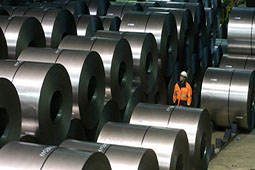
DEN Events: Top Brass of Iran Steel Industry Warm Up to ISMC 2019


On Tuesday, the first preparatory meeting of the ninth iteration of this prime steel event in 2019 was hosted by Donya-e-Eqtesad Media Group, the parent company of the Financial Tribune and the organizer of the conference.
For their parts, steel industrialists called on the government, the Ministry of Industries, Mining and Trade in particular, to remove restrictive rules and regulations related to exports, state-enforced pricing and uncertain policies in the foreign currency market.
The suggested themes of ISMC 2019, which is scheduled to be held at the Islamic Republic of Iran Broadcasting’s International Conference Center in Tehran on Jan. 29-30, as discussed in the meeting, include:
- Significance of sustainable development of infrastructures (water, power, roads, railroads, etc);
- Modern technologies, recycling, alloys and optimization of production costs;
- Significance of development of exploration and extraction to complete the chain of steel production;
- Opportunities and challenges facing exports and domestic sales of iron ore and steel products;
- Challenges associated with fluctuations in foreign exchange rates and their impact on production, supply and demand;
- Investment, growth and development;
- Human resources, their training and empowerment, as well as productivity;
- Water, energy and environment.
Government officials and prominent steel business figures, including Deputy Minister of Industries, Mining and Trade Jafar Sarqeini, a member of Majlis Commission of Councils and Domestic Affairs Abdolreza Hashemzaei, President of Iran-Iraq Chamber of Commerce Yahya Al-e Es'haq, Managing Director of Iran's biggest steelmaker Mobarakeh Steel Company Hamid Reza Azimian, the head of Middle East Mines and Mining Industries Development Holding Company, Reza Ashraf-Semnani, the head of Iranian Steel Producers Association, Rasoul Khalifeh-Soltan, and the head of Iran Mine House, Mohammad Reza Bahraman, attended the Tuesday meeting.
Other participants included Chairman of Iron Ore Producers and Exporters Association of Iran Mehrdad Akbarian, the deputy head of Iranian Iron Ore Producers and Exporters Association, Bahram Shakouri, Managing Director of Golgohar Mining and Industrial Complex Nasser Taqizadeh and CEO of Chadormalu Mining and Industrial Complex Mahmoud Nourian.
Sarqeini, who presided over the meeting, said he believed the challenges facing exports after the reimposition of sanctions should take the center-stage in the conference.
The American sanctions were reinstated in two waves, one in August and another in November, after US President Donald Trump announced his unilateral walkout from the nuclear deal Iran signed with world powers in 2015.
“Despite the close to 23% growth in exports during the first half of the current year (March 21-Sept. 22), both exports and domestic consumption of steel are bound to decline in the second half of the year, so there is need to weigh in on the ways to tackle the looming meltdown in the industry,” he said.
Latest data released by the Iranian Mines and Mining Industries Development and Renovation Organization show a total of 3.88 million tons of semi-finished and finished steel products were exported from Iran during the first seven months of the current fiscal year (March 21-Oct. 22) to register a year-on-year contraction of 3%.
The mills shipped out 364,215 tons of steel during the seventh month of the year (Sept. 22-Oct. 22), which signified a downturn of 17% compared with the same month of the year before.
As part of the 20-Year Vision Plan, Iran aims to become the world’s seventh largest steelmaker after reaching a crude steelmaking capacity of amassing 55 million tons per year. More than half of this capacity has already been realized, yet the viability of boosting it to the targeted figure depends on not only maintaining the export markets but also on finding new ones.
The reimposition of sanctions will no doubt be a major challenge. This comes against the backdrop of the recession-hit domestic housing sector, which is the main consumer of steel and steel products.


Trump weighs using $2 billion in CHIPS Act funding for critical minerals

Codelco cuts 2025 copper forecast after El Teniente mine collapse

Electra converts debt, launches $30M raise to jumpstart stalled cobalt refinery

Barrick’s Reko Diq in line for $410M ADB backing

Abcourt readies Sleeping Giant mill to pour first gold since 2014

Nevada army depot to serve as base for first US strategic minerals stockpile

SQM boosts lithium supply plans as prices flick higher

Viridis unveils 200Mt initial reserve for Brazil rare earth project

Tailings could meet much of US critical mineral demand – study

Kyrgyzstan kicks off underground gold mining at Kumtor

Kyrgyzstan kicks off underground gold mining at Kumtor

KoBold Metals granted lithium exploration rights in Congo

Freeport Indonesia to wrap up Gresik plant repairs by early September

Energy Fuels soars on Vulcan Elements partnership

Northern Dynasty sticks to proposal in battle to lift Pebble mine veto

Giustra-backed mining firm teams up with informal miners in Colombia

Critical Metals signs agreement to supply rare earth to US government-funded facility

China extends rare earth controls to imported material

Galan Lithium proceeds with $13M financing for Argentina project

Kyrgyzstan kicks off underground gold mining at Kumtor

Freeport Indonesia to wrap up Gresik plant repairs by early September

Energy Fuels soars on Vulcan Elements partnership

Northern Dynasty sticks to proposal in battle to lift Pebble mine veto

Giustra-backed mining firm teams up with informal miners in Colombia

Critical Metals signs agreement to supply rare earth to US government-funded facility

China extends rare earth controls to imported material

Galan Lithium proceeds with $13M financing for Argentina project

Silver price touches $39 as market weighs rate cut outlook

















